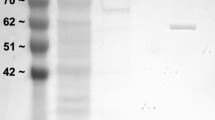Summary
-
1.
The activities of “key enzymes” representing the anaerobic pathway (GAPDH, LDH, ODH, PK, PEPCK, GPT, CS) in the adductor muscle of six species of mussels, the freshwater formsAnodonta cygnea, Dreissena polymorpha, andUnio spec. and the marine bivalvesCardium edule, Mya arenaria, andMytilus edulis, were assayed and compared with those in muscles from Crustacea and Amphibia (tail of the freshwater crayfishOrconectes limosus and gastrocnemius ofRana temporaria).
-
2.
The glycolytic capacity (as indicated by the activity of GAPDH) of the adductor muscles is relatively low and the ability to produce lactate (as indicated by the activity of LDH) is very low. There are, however, high activities of enzymes essential for the production of succinate and octopine.
-
3.
The glycogen stores of the adductor muscles from mussels were found to be significantly higher than in the muscles of Crustacea and Amphibia.
Zusammenfassung
-
1.
Die Aktivitäten von „Schlüsselenzymen” des Anaerobiosestoffwechsels (GAPDH, LDH, ODH, PK, PEPCK, GPT, CS) wurden in den Schalenschließmuskeln von sechs verschiedenen Muschelarten, den SüßwasserformenAnodonta cygnea, Dreissena polymorpha undUnio spec. sowie den marinen BivalviernCardium edule, Mya arenaria undMytilus edulis, bestimmt und mit denen in glykolysierenden Muskeln der Crustaceen bzw. Amphibien verglichen (Schwanzmuskel vonOrconectes limosus bzw. Gastrocnemius vonRana temporaria).
-
2.
Die Kapazität des Embden-Meyerhof-Weges (gemessen als Aktivität der GAPDH) der Muschelmuskeln ist verhältnismäßig gering, ihre Fähigkeit zur Lactatbildung (gemessen als Aktivität der LDH) minimal. Anstatt dessen konnten hohe Aktivitäten derjenigen Enzyme nachgewiesen werden, die für die Succinatgärung bzw. Octopingärung (?) essentiell sind.
-
3.
Die Muschelmuskeln enthalten ein deutlich größeres Depot an Glykogen als die untersuchten Muskeln der Crustaceen und Amphibien.
Similar content being viewed by others
Literatur
Bergmeyer, H. U.: Methoden der enzymatischen Analyse, 2. Aufl. Weinheim: Verlag Chemie 1970
Brand, T. von: Der Stoffwechsel vonAscaris lumbricoides bei Oxybiose und Anoxybiose. Z. vergl. Physiol.21, 220–235 (1934)
Bueding, E.: Studies on the metabolism of the filarial worm,Litomosoides carinii. J. exp. Med.89, 107–130 (1949)
Bueding, E., Farrow, G. W.: Identification of succinic acid as a constituent of the perienteric fluid ofAscaris lumbricoides. Exp. Parasit.5, 345–349 (1956)
Bueding, E., Saz, H. J.: Pyruvate kinase and phosphoenolpyruvate carboxykinase activities ofAscaris muscle,Hymenolepis diminuta andSchistosoma mansoni. Comp. Biochem. Physiol.24, 511–518 (1968)
Bueding, E., Yale, H.: Production of α-methylbutiric acid by bacteriafreeAscaris lumbricoides. J. biol. Chem.193, 411–423 (1951)
Bunge, G.: Weitere Untersuchungen über die Atmung der Würmer. Hoppe-Seylers Z. physiol. Chem.14, 318–324 (1889)
Chen, C., Awapara, J.: Intracellular distribution of enzymes catalyzing succinate production from glucose inRangia mantle. Comp. Biochem. Physiol.30, 727–737 (1969a)
Chen, C., Awapara, J.: Effect of oxygen on the end-products of glycolysis inRangia cuneata. Comp. Biochem. Physiol.31, 395–401 (1969b)
Fairbairn, D., Wertheim, G., Harpur, R. P., Schiller, E. L.: Biochemistry of normal and irradiated strains ofHymenolepis diminuta. Exp. Parasit.11, 248–263 (1961)
Gäde, G.: Unveröffentlichte Ergebnisse
Hammen, C. S., Lum, S. C.: Fumarate reductase and succinate dehydrogenase activities in bivalve molluscs and brachiopods. Comp. Biochem. Physiol.19, 775–781 (1966)
Kmetec, E., Bueding, E.: Succinic and reduced diphosphopyridine nucleotide oxidase systems ofAscaris muscle. J. biol. Chem.236, 584–591 (1961)
Kmetec, E., Bueding, E.: Production of succinate by the canine whipwormTrichuris vulpis. Comp. Biochem. Physiol.15, 271–274 (1965)
Malanga, C. J., Aiello, E. L.: Succinate metabolism in the gills of the musselsModiolus demissus andMytilus edulis. Comp. Biochem. Physiol.43 B, 795–806 (1972)
Pette, D.: Plan und Muster im zellulären Stoffwechsel. Naturwissenschaften52, 597–616 (1965)
Pette, D.: Metabolic differentiation of distinct muscle types at the level of enzymatic organization. In: Pernow, B., Saltin, B., eds., Muscle metabolism during exercise. New York: Plenum Press 1971
Prichard, R. K., Schofield, P. J.: The glycolytic pathway in adult liver fluke,Fasciola hepatica. Comp. Biochem. Physiol.24, 697–710 (1968a)
Prichard, R. K., Schofield, P. J.: Phosphoenolpyruvate carboxykinase in the adult liver fluke,Fasciola hepatica. Comp. Biochem. Physiol.24, 773–785 (1968b)
Regnouf, F., Thoai, N. van: Octopine and lactate dehydrogenases in mollusc muscles. Comp. Biochem. Physiol.32, 411–416 (1970)
Robin, Y., Thoai, N. van: Métabolisme des dérivés guanidylés. — X. Métabolisme de l'octopine: son rôle biologique. Biochim. biophys. Acta (Amst.)35, 446–453 (1961)
Saz, H. J., Lescure, O. L.: The functions of phosphoenolpyruvate carboxykinase and malic enzyme in the anaerobic formation of succinate byAscaris lumbricoides. Comp. Biochem. Physiol.30, 49–60 (1969)
Saz, H. J., Vidrine, A.: The mechanism of formation of succinate and propionate byAscaris lumbricoides muscle. J. biol. Chem.234, 2001–2005 (1959)
Simpson, J. W., Awapara, J.: Phosphoenolpyruvate carboxykinase activity in invertebrates. Comp. Biochem. Physiol.12, 457–464 (1964)
Simpson, J. W., Awapara, J.: The pathway of glucose degradation in some invertebrates. Comp. Biochem. Physiol.18, 531–548 (1966)
Speck, U.: Das Kohlenhydratspektrum in den Organen des FlußkrebsesOrconectes limosus und seine Veränderungen im Jahresablauf. Z. vergl. Physiol.65, 51–69 (1969)
Stokes, T. M., Awapara, J.: Alanine and succinate as end-products of glucose degradation in the clamRangia cuneata. Comp. Biochem. Physiol.25, 883–892 (1968)
Thoai, N. van, Robin, Y.: Métabolisme des dérivés guanidylés. — VIII. Biosynthése de l'octopine et répartition de l'enzyme chez les invertébrés. Biochim. biophys. Acta (Amst.)35, 446–453 (1959)
Wegener, B. A., Barnitt, A. E., Hammen, C. S.: Reduction of fumarate and oxidation of succinate inCrassostrea virginica (Gmelin). Life Sci.8, 335–343 (1969)
Weinland, E.: Über Kohlehydratzersetzung ohne Sauerstoffaufnahme beiAscaris, einen tierischen Gärungsprozeß. Z. Biol.42, 55–90 (1901)
Weinland, E.: Über die vonAscaris lumbricoides ausgeschiedene Fettsäure. Z. Biol.45, 113–116 (1904)
Zoeten, L. W. de, Tipker, J.: Intermediary metabolism of the liverflukeFasciola hepatica. — II. Hoppe-Seylers Z. physiol. Chem.350, 691–695 (1969)
Zwaan, A. de: Pyruvate kinase in muscle extracts of the sea musselMytilus edulis L. Comp. Biochem. Physiol.42B, 7–14 (1972)
Zwaan, A. de, Marrewijk, J. A. van: Anaerobic glucose degradation in the sea musselMytilus edulis L. Comp. Biochem. Physiol.44B, 429–439 (1973)
Zwaan, A. de, Zandee, D. J.: Body distribution and seasonal changes in the glykogen content of the common sea musselMytilus edulis L. Comp. Biochem. Physiol.43A, 53–58 (1972a)
Zwaan, A. de, Zandee, D. J.: The utilization of glykogen and accumulation of some intermediates during anaerobiosis inMytilus edulis L. Comp. Biochem. Physiol.43B, 47–54 (1972b)
Author information
Authors and Affiliations
Rights and permissions
About this article
Cite this article
Gäde, G., Zebe, E. Über den Anaerobiosestoffwechsel von Molluskenmuskeln. J. Comp. Physiol. 85, 291–301 (1973). https://doi.org/10.1007/BF00694235
Received:
Issue Date:
DOI: https://doi.org/10.1007/BF00694235




